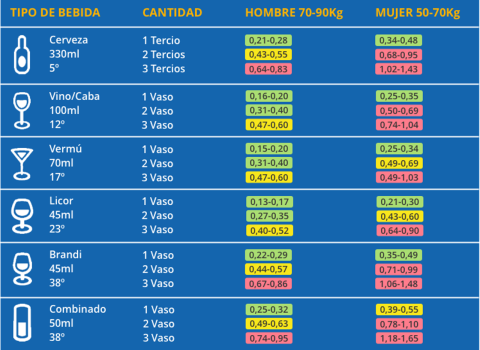
In the following article you will find everything you need to know about the maximum blood alcohol level in Spain and what you have to drink to overcome it.
First of all, the maximum blood alcohol level that all drivers should have in a test is 0.0. However, the law offers a certain margin and this can encourage the consumption of alcoholic beverages before getting behind the wheel of a vehicle. So that it does not end in a fine, this is the maximum blood alcohol level in Spain and some examples of what you have to drink to overcome it.
According to the DGT, alcohol is present in between 30% and 50% of fatal accidents. For this reason, Traffic persecutes and severely punishes those drivers who get behind the wheel after having ingested a large amount of alcoholic beverages with the aim of reducing this high percentage and achieving safer roads to travel on.
What is the maximum blood alcohol level allowed in Spain?
The maximum blood alcohol level allowed in Spain varies depending on the type of driver and the measurement that is carried out. We must separate between drivers in general, professional and novice drivers. Also enter the type of measurement, either blood (measured in grams per liter) or expired air (measured in milligrams per liter).
In this way, in Spain the maximum starting blood alcohol level is as follows:
| driver type | in blood | in expired air |
| drivers in general | 0.5g/l | 0.25mg/l |
| novice drivers | 0.3g/l | 0.15mg/l |
| professional drivers | 0.3g/l | 0.15mg/l |
Despite these margins, the DGT reminds that, “even below the legal limit, the risk of an accident may already be increased”. For this reason, “it is best to avoid driving after having consumed any amount of alcohol.”
How much do you have to drink to exceed the maximum rate?
The General Directorate of Traffic has prepared an interesting table that shows the most common type of alcoholic beverage consumed and the number of drinks that a man and a woman of a certain weight can drink before giving a positive result.
It is worth mentioning that this table is an example, since alcohol affects each individual differently and that a long list of factors will interfere to produce a higher or lower alcohol level.
In the table you can find drinks such as beer, wine, liquor, brandy or mixed drinks. Also the number of drinks or glasses and the indicative results that a man weighing between 70 and 90 kilos, and a woman weighing between 50 and 70 kilos, would yield in a breathalyzer test:
In addition, the BAC level will depend on factors such as:
- The amount of alcohol ingested.
- The speed with which the drink is ingested.
- The characteristics of the alcohol that is drunk.
- Have an empty or full stomach.
- Age and driving experience.
- The sex and weight of the person.
- The hour of the day.
- Personal circumstances (fatigue, drowsiness, anxiety…).
What are the fines for testing positive for alcohol at the wheel?
Finally, here you will find a table that shows the economic fines and the withdrawal of points from the driving license in the hypothetical case of exceeding the maximum alcohol rate allowed in Spain:
| Driver | Reason | Penalty fee | Points |
| Underage driver in any type of vehicle | Exceed the rate of 0.0 mg/l and 0.0 g/l | 500 euros | Without points |
| Novice and professional driver | Rate 0.15 mg/l or 0.30 g/l | 500 euros | 4 points |
| overall driver | Rate 0.25-0.50 mg/l or 0.50 g/l | 500 euros | 4 points |
| Novice and professional driver | Rate 0.30mg/l | 1000 euros | 6 points |
| overall driver | Upper rate 0.50 mg/l | 1000 euros | 6 points |
| repeat offenders | Relapse | 1000 euros | 4 to 6 points |
In addition to these fines, there are two other sanctions considered very serious that carry higher penalties:
-
Expired air rate greater than 0.60 mg/l or 1.2 g/l in blood: imprisonment for 3 to 6 months or fine for 6 to 12 months or work for the benefit of the community for 30 to 90 days and deprivation of the right to drive from 1 to 4 years.
-
Refusal to submit to alcohol tests: imprisonment from 6 months to 1 year and deprivation of the right to drive from 1 to 4 years.
Source: General Directorate of Traffic
